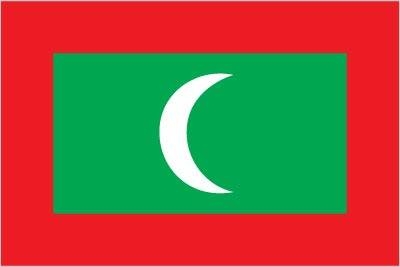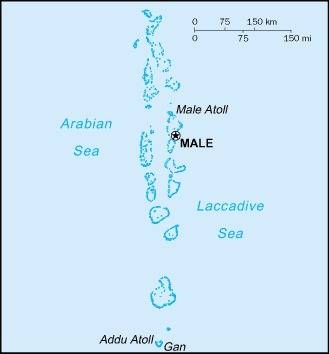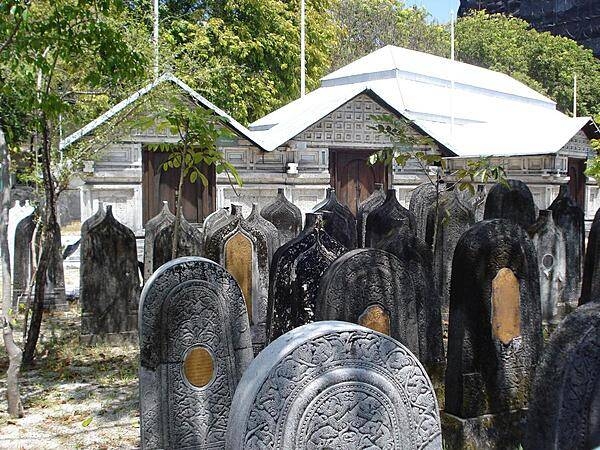153 Maldives

Red with a large green rectangle in the center bearing a vertical white crescent moon. The closed side of the crescent is on the hoist side of the flag. Red recalls those who have sacrificed their lives in defense of their country, the green rectangle represents peace and prosperity, and the white crescent signifies Islam.
Flag courtesy of the CIA World Factbook

Map courtesy of the CIA World Factbook

The Royal Graveyard in Male is near the Grand Friday Mosque and contains the tombs of the country’s heroes and members of royalty.
Photo courtesy of the CIA World Factbook
Government
According to Britannica, the constitution of the Maldives was adopted in 2008. The head of state and government is the president, assisted by a vice president and a cabinet. The president and vice president are directly elected by universal suffrage to a maximum of two five-year terms. The cabinet consists of the vice president, government ministers, and the attorney general. With the exception of the vice president, members of the cabinet are appointed by the president.
The unicameral legislature, called the People’s Majlis, meets at least three times per year. Its members are elected to five-year terms from Male island and from each of the 20 atoll groups into which the country is divided for administrative purposes. The number of representatives from each administrative division is determined on the basis of population, with a minimum of two per division. The 2008 constitution established Islam as the official state religion. Non-Muslims cannot become citizens, and the People’s Majlis is prohibited from making any law that contravenes the tenets of Islam. Other governmental bodies include civil service and human rights commissions.
The highest legal authority is the Supreme Court. Its judges are appointed by the president in consultation with the Judicial Service Commission, a body of 10 members appointed or elected from various branches of the government and the general public. The Judicial Service Commission independently appoints all other judges. There are no judicial term limits; the mandatory retirement age is 70. All judges must be Sunni Muslims. The Supreme Court bases decisions upon the constitution and Maldives law; in cases in which applicable law does not exist, Sharīʿah (Islamic law) is considered. Other courts are the High Court and trial courts.
Maldives Civil Aviation Authority (CAA)
Maldives Civil Aviation Authority (CAA) was established by the Parliament under Act No.02/2012 on 11th January 2012. The CAA aims to develop and administer policies and regulations to ensure safe, secure, orderly and economic development of aviation in the Maldives. CAA places great emphasis on adopting highest common standards of safety and environmental protection in civil aviation. Their vision is to achieve regulatory excellence in aviation safety and security through a well motivated work force. The main tasks of CAA are setting up national safety standards which are compliant with international standards; economic and safety regulation through regulation of airports, air traffic services and airlines.
Airspace
SkyVector – Google Maps – ADS-B Exchange
ICAO countries publish an Aeronautical Information Publication (AIP). This document is divided into three parts: General (GEN), En Route (ENR) and Aerodromes (AD). ENR 1.4 details the types of airspace classes they chose to adopt from classes A through G.
Drone Regulations
Flying Remotely Piloted Aircraft (Drones) in the Maldives
Advanced Air Mobility (AAM) Regulations & Policies
None found by the author.
However, should you, the reader, happen to stumble across something to the contrary, please email the author at FISHE5CA@erau.edu and you may be mentioned in the ACKNOWLEDGEMENTS section of this book by way of thanks for contributing to this free eBook!
Advanced Air Mobility (AAM) News
2024 – Air Chateau, partners to develop vertiport network in Maldives
Short Essay Questions
Scenario-Based Question
You have been hired by a Drone Startup Company. Your boss has immediately assigned this job to you.
They need you to prepare a one-page memo detailing the legalities of using a drone to film the graveyard in Male, pictured above.
They need you to mention any national laws and local ordinances.
They specifically want to know what airspace (insert pictures) you will be operating in and whether or not you need an airspace authorization.
Does it matter whether or not you are a citizen of the country?
Lastly, there is a bonus for you if, as you scroll through this chapter, you find any typos or broken links!
Short Essay Questions
- What are the drone categories?
- How is registration addressed?
- How is remote ID addressed?
- What are the model aircraft rules?
- What are the commercial drone rules?
- Are there waivers or exemptions to the rules? If so, for what?
- Would you share a link to an interactive airspace map?
- How is BVLOS addressed?
- How can you fly drones at night?
- How can you fly drones over people?
- Where do you find drone NOTAMs?
- What are the rules for drone maintenance?
- What are the rules for an SMS program?
- What are some unique rules not mentioned above?
- What are the C-UAS rules?
- What are the AAM rules?

